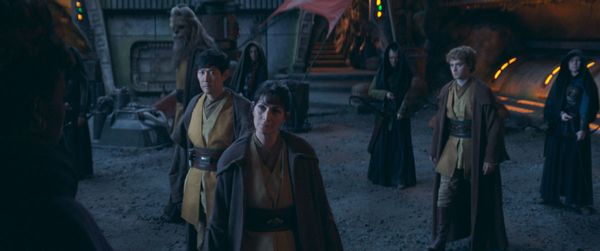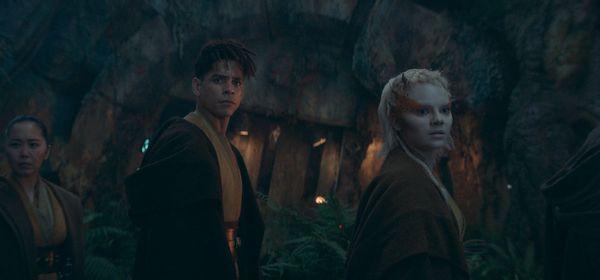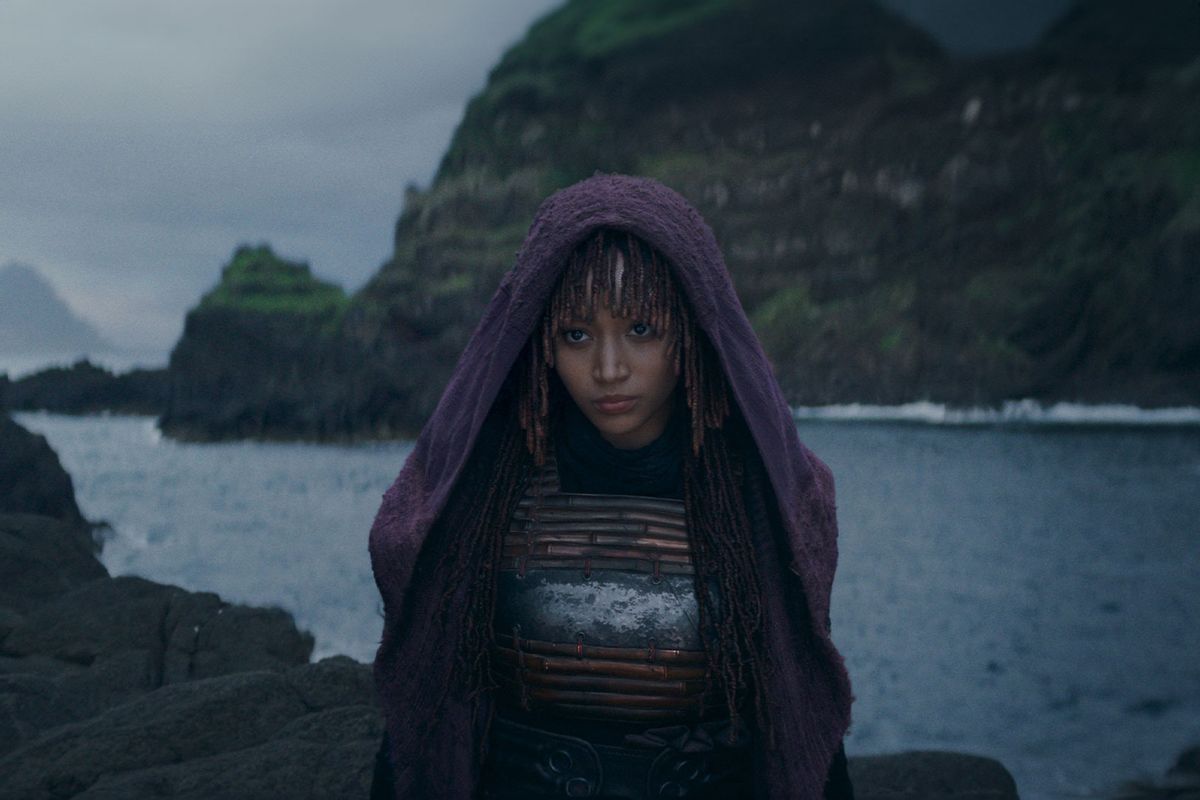Five years’ worth of “Star Wars” shows has provided enough evidence for a person to suspect that the extensively known canon fans revere has also creatively shacked it. Instead of expanding the universe in new ways, the corporate dream machine plugged into familiar characters and artifacts. Recent series hinged upon the adventures of young-ish Obi-Wan Kenobi and younger Leia, adult Ahsoka, and an unmasked Boba Fett.
At least “The Mandalorian” expands the culture behind some very familiar armor using characters most viewers knew nothing about before watching it.
“Star Wars: The Acolyte” does something similar with the franchise’s most emblematic figures, which would be a snooze if not for their role in a story that asks us to question our presumed faith in their righteousness.
Generations who came of age with George Lucas’ fantasies had the light versus dark side, Jedi versus Sith dichotomy drilled into us along with the assurance that Force-wielders, besides being special, belonged to one team or the other. The first six movies packaged this alongside an unsubtle version of misogyny: nearly all human Jedi with lines were white guys until Samuel L. Jackson.
“Acolyte” creator and showrunner Leslye Headland wipes those images away within the opening frames of the series when a young woman (Amandla Stenberg) rolls up to Master Indara (Carrie-Anne Moss) in a tavern and challenges her to fight. The ensuing battle is a slice of straight-up action movie fan fic, pitting Trinity from “The Matrix” movies against an ace fighter with a vendetta a la “Kill Bill” – except, again, this is “Star Wars.”
Headland, who co-created “Russian Doll,” knows exactly which buttons she’s pushing by leading with this scene in the same way Disney and Lucasfilm are cunning to use an economic montage of its highlights to promote the show.
Both women are unknown characters, with one of them representing an unknown faction. The show itself arrives in a cloud of mystery, limiting which specifics we can detail.
What I can say is that Headland takes a relatively ordinary plot device and uses it as a vehicle to do some quietly revolutionary storytelling – again, by “Star Wars” standards.
 Lee Jung-jae and Carrie-Anne Moss in “Star Wars: The Acolyte” (Lucasfilm/Disney+)
Lee Jung-jae and Carrie-Anne Moss in “Star Wars: The Acolyte” (Lucasfilm/Disney+)
Liberated from most aspects of the Skywalker saga, she and her writers take a relatively simple fugitive mystery tale and use it to remind us of the patriarchal and spiritual colonialism inherent to the galaxy’s foremost religious order.
It’s also a ripping, nimbly paced action series that knows its audience and knows how to exploit this fandom’s strengths and weak spots. Let’s just say that Moss isn’t the main star here. That honor goes to Stenberg, who plays two roles, Osha and Mae, along with “Squid Game” star Lee Jung-jae as Sol, a Jedi Master tasked with finding a rogue Force user whose skills are formidable and troubling.
“This is about power . . . and who is allowed to use it.”
“The Acolyte” is set a century before the rise of the Empire when the Jedi Order managed the galaxy – meaning, lots of rough robes, humming lightsabers and battles between opponents who fling each other around without touching. But it also pre-dates many other traditions which may be why Lee and other stars seem freer to emote.
No new addition to this entertainment catalog can be entirely divorced from everything we’ve already seen. In the slightest details of that opaque description, we recognize a few repeating refrains: Osha and Mae are twins. The Jedi’s adversary is presumably evil; we already know of such a group. Perhaps this show explores their origins, but the four episodes provided for review don’t show anything definitive that would indicate that.
Driving the season is a straightforward crime-solving arc that seems simplistic next to the do-or-die sagas driving nearly every other installment in this library besides “Andor.” The ticking time bomb in “The Acolyte” ostensibly comes down to saving a group of individuals that the galaxy probably wouldn’t miss from a nobody with an axe to grind. There are no planets at stake, no rebellion whose survival teeters on a knife’s edge.
Some people are going to absolutely hate that.
But in the same way that “Andor” used its title character to navigate a parable about how fascism has a way of rising from rampant corporate greed, “The Acolyte” is at its best when it asks both its protagonists and the audience to question our blind faith in the concept of so-called law and order.
It hints that in an opening title card that forgoes the long crawl to simply describe the era as a time of peace, explaining that The Jedi Order and the Galactic Republic “have prospered for centuries without war.” For such a political arrangement to prosper, there must be the necessary tension of an antagonist being kept at bay. As a perfectly reasonable character points out in an upcoming episode, some conflicts don’t originate from which side is “good” and which is “bad”: “This is about power,” they say, “and who is allowed to use it.”
 Charlie Barnett and Dafne Keen in “Star Wars: The Acolyte” (Lucasfilm/Disney+)
Charlie Barnett and Dafne Keen in “Star Wars: The Acolyte” (Lucasfilm/Disney+)
Moss may beckon viewers to “The Acolyte,” but beyond her role, the show places the most weight on Stenberg, who evokes a natural duality in her sisters that sidesteps the usual pitfalls of such performances.
The opening quartet of installments doesn’t feature her acting against herself yet, which is the real test of how well an actor pulls off believably playing her double. But she plays the more shadowed of the siblings without any of the flat spikes and splinters of pure evil that inform most of the hostile beings in this universe.
Want a daily wrap-up of all the news and commentary Salon has to offer? Subscribe to our morning newsletter, Crash Course.
Lee balances this with a performance soaked in empathy and regret, granting his physical confrontations with the lost soul he’s tracking a hint of operatic pathos. Setting this bar allows the actors playing other knights of his order and his padawan Jecki Lon (Dafne Keen) to accordingly relax or stiffen up.
Charlie Barnett’s Yord Fandar is wound especially tight when it comes to dealing with Osha, which doesn’t allow for the actor to showcase the admirable range and subtleties of which he avails himself in “Russian Doll.” Mae, on the other hand, has a lazy and barely trustworthy smuggler pal Qimir (Manny Jacinto), making it tough to determine which sister is on the less desirable team.
Ultimately these characters’ personalities matter less than what they represent on the moral scale instead of how closely they hew to established “Star Wars” canon. “The Acolyte” carries fewer of those weights, allowing it the space to reconsider our dogmatic devotion to one of cinema’s exemplary institutions of heroism.
There’s much to appreciate about a show that cunningly strives not only to be deemed good but to make us redefine what that means. And it only took looking farther into this saga’s distant past to move ahead in ways its storytelling can challenge us.
“Star Wars: The Acolyte” debuts with two episodes Tuesday, June 4 at 6 p.m. PT / 9 p.m. ET on Disney+.
Read more
about “Star Wars”

